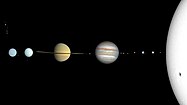Wikipedia:Today's featured article/October 29, 2023
The Solar System is the gravitationally bound system of the Sun and the objects that orbit it. There are eight planets, numerous dwarf planets, the asteroid belt between Mars and Jupiter, the Kuiper belt, and the scattered disc beyond Neptune's orbit. The Solar System was formed 4.6 billion years ago from the gravitational collapse of an interstellar molecular cloud, which formed the Sun and a protoplanetary disk that coalesced into other objects. Many celestial bodies have natural satellites orbiting them, and all giant planets and a few smaller bodies are encircled by planetary rings. Many small-body populations, including comets, centaurs, and interplanetary dust clouds, freely travel between the Solar System's regions. The solar wind, a stream of charged particles flowing outwards from the Sun, creates a heliosphere region. The Oort cloud may extend roughly a thousand times farther than the heliosphere. (This article is part of a featured topic: Solar System.)
